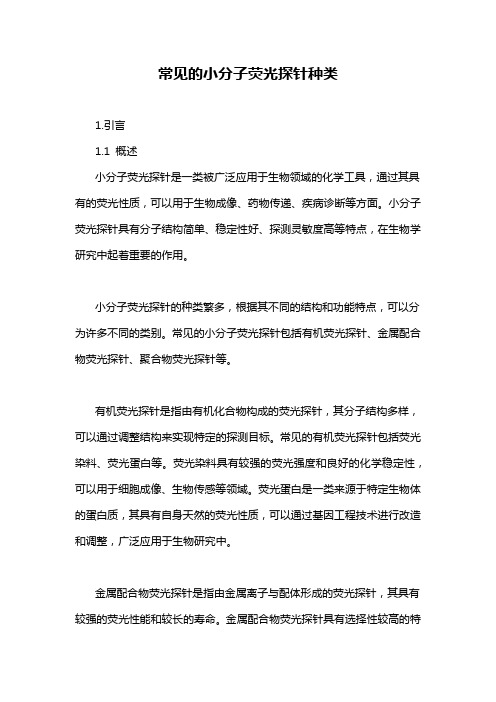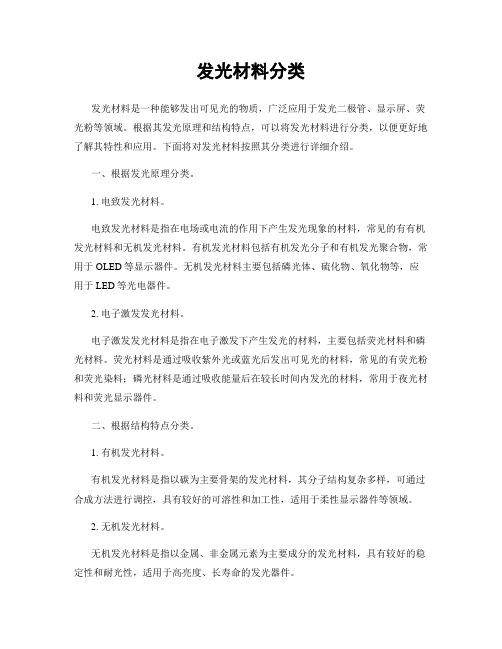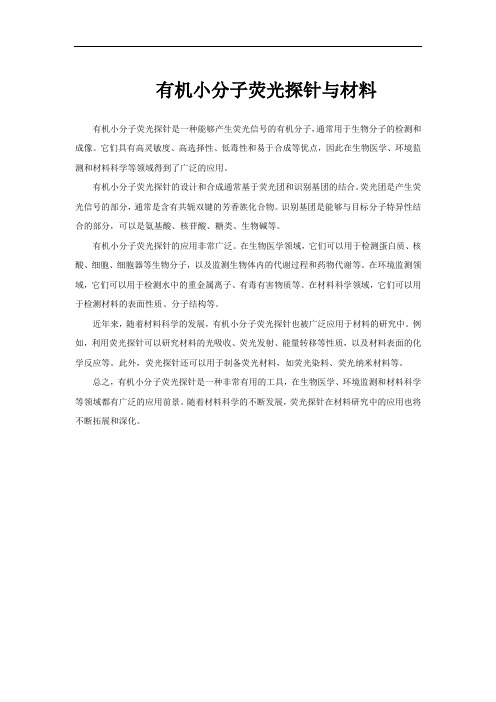有机小分子荧光材料的分类
oled有机发光材料 类型

oled有机发光材料类型
有机发光材料是一种能够通过电流驱动发出光的材料。
在有机发光二极管(OLED)中,有机发光材料被用作发光层。
根据发光机制的不同,有机发光材料可分为以下几种类型:1. 有机小分子材料(Small molecule OLED,
SM-OLED):这种类型的有机发光材料由有机小分子构成,如三联芳胺(TPD)和氧化亚蒽(Alq3)。
有机小分子材料具有高纯度、高亮度和高耐久性的特点。
2. 有机聚合物材料(Polymer OLED, P-OLED):这种类型的有机发光材料采用有机聚合物作为发光层。
有机聚合物材料具有高色彩纯度、易于制备大面积器件等优点。
3. 有机小分子/有机聚合物混合材料(Small molecule/Polymer OLED hybrid, H-OLED):这种类型的有机发光材料将有机小分子和有机聚合物组合在一起使用,发挥两者的优点,例如高电荷传输性能和高色彩纯度。
这些不同类型的有机发光材料在OLED显示器和照明领域都有应用。
荧光材料

2020/4/10
17
3 荧光材料的应用
3.2 反光材料
传统的完全反光材料
2020/4/10
18
3 荧光材料的应用
荧光在反光材料中的应用 不仅能反光,还能在受到光照时辐射出
光子,比普通的反光材料看上去更醒目, 比如硫系材料
侧链型
• 小分子发光基团挂接在高分子侧链 上
全共轭主 链型
• 整个分子均为一个大的共轭高分子 体系
部分共轭 主链型
• 发光中心在主链上,但发光中心之 间相互隔开没有形成一个共轭体系
2020/4/10
14
2 荧光材料分类
目前所研究的高分子发光材料主要是共 轭聚合物,如聚苯、聚噻吩、聚三苯基 胺及其衍生物等
燃烧法、溶胶-凝胶法、水热沉淀法、微波法 等
YBO3:Eu——橙红色荧光
2020/4/10
11
2 荧光材料分类
2.2 有机小分子荧光材料 有机小分子发光材料种类繁多,它们多
带有共轭杂环及各种生色团,结构易于 调整,通过引入各种生色团来改变其共 轭长度,从而使化合物光电性质发生变 化
2020/4/10
2020/4/10
8
1 背景介绍
荧光 or 萤光
1 “萤”字在古 汉语中与“荧” 字通假
在台湾多称萤 光,在中国大 陆多称荧光
2 荧光
fluorescence 光致发光
萤光 luminescence 生物发光
2020/4/10
9
2 荧光材料分类
2.1 无机荧光材料
以稀土荧光材料为代表
稀土离子具有丰富的能级和 4f 电子跃迁特性 吸收能力强,转换率高,且物理化学性质稳定
延迟荧光分子

延迟荧光分子延迟荧光分子是一种新型的荧光探针,具有较长的寿命和较高的量子产率。
它们在生物医学、材料科学和化学分析等领域中有着广泛的应用前景。
本文将从以下几个方面详细介绍延迟荧光分子。
一、概述延迟荧光分子是一类具有长寿命的荧光探针,其寿命通常在微秒到毫秒级别,比传统荧光探针长得多。
这种长寿命使得它们可以用于更加复杂的生物体系和化学反应中。
此外,延迟荧光分子还具有较高的量子产率,即每个激发态分子能够发射出更多的荧光光子,从而提高了检测灵敏度。
二、分类目前已经发现了多种类型的延迟荧光分子,其中包括:1. 金属有机框架材料(MOFs):这些材料由金属离子和有机配体组成,可以通过调整配位基团来改变其发射寿命和波长。
2. 有机小分子:这些化合物通常具有芳香环结构和延迟荧光基团,如三苯胺、三苯基胺等。
3. 聚合物:这些材料由多个单元组成,可以通过调整单元之间的距离和相互作用来改变其荧光性质。
三、应用1. 生物医学领域:延迟荧光分子可以用于生物体内的病理诊断和治疗监测。
例如,它们可以被用作肿瘤标记物或者针对特定靶点的探针,从而实现高灵敏度的检测。
2. 化学分析领域:延迟荧光分子可以被用于检测各种化学物质,如重金属、有机污染物等。
它们还可以通过与其他分子进行特异性识别来实现高选择性的检测。
3. 材料科学领域:延迟荧光分子可以被应用于制备新型发光材料和器件。
例如,它们可以被用于制备高效的有机发光二极管(OLEDs),从而提高其亮度和寿命。
四、制备方法目前制备延迟荧光分子的方法主要包括以下几种:1. 合成有机小分子:这是制备延迟荧光分子的最常用方法。
通过在有机小分子中引入延迟荧光基团,可以得到具有长寿命和高量子产率的化合物。
2. 合成金属有机框架材料:这种方法可以通过控制金属离子和有机配体之间的配位作用来调节材料的发射寿命和波长。
3. 聚合物合成:这种方法可以通过调整单元之间的距离和相互作用来改变材料的荧光性质。
五、发展前景随着对延迟荧光分子性质的深入研究,人们对它们在生物医学、化学分析和材料科学等领域中的应用前景也越来越看好。
常见的小分子荧光探针种类

常见的小分子荧光探针种类1.引言1.1 概述小分子荧光探针是一类被广泛应用于生物领域的化学工具,通过其具有的荧光性质,可以用于生物成像、药物传递、疾病诊断等方面。
小分子荧光探针具有分子结构简单、稳定性好、探测灵敏度高等特点,在生物学研究中起着重要的作用。
小分子荧光探针的种类繁多,根据其不同的结构和功能特点,可以分为许多不同的类别。
常见的小分子荧光探针包括有机荧光探针、金属配合物荧光探针、聚合物荧光探针等。
有机荧光探针是指由有机化合物构成的荧光探针,其分子结构多样,可以通过调整结构来实现特定的探测目标。
常见的有机荧光探针包括荧光染料、荧光蛋白等。
荧光染料具有较强的荧光强度和良好的化学稳定性,可以用于细胞成像、生物传感等领域。
荧光蛋白是一类来源于特定生物体的蛋白质,其具有自身天然的荧光性质,可以通过基因工程技术进行改造和调整,广泛应用于生物研究中。
金属配合物荧光探针是指由金属离子与配体形成的荧光探针,其具有较强的荧光性能和较长的寿命。
金属配合物荧光探针具有选择性较高的特点,可以用于特定金属离子的探测和诊断。
常见的金属配合物荧光探针包括铜离子、锌离子、铁离子等的配合物。
聚合物荧光探针是指由高分子聚合物构成的荧光探针,其具有较好的溶解性和稳定性。
聚合物荧光探针可以通过调整聚合物的结构和链长来实现特定的探测需求。
常见的聚合物荧光探针包括聚合物分子探针、聚合物纳米探针等。
总之,常见的小分子荧光探针种类繁多,具有不同的结构和功能特点,可以根据具体的研究需求选择适合的荧光探针进行应用。
这些小分子荧光探针为生物学研究提供了有力的工具,有助于深入理解生命的基本过程和疾病的发生机制。
未来,随着技术的不断发展和突破,相信小分子荧光探针在生物领域的应用会得到更广泛的推广和应用。
1.2文章结构1.2 文章结构本文主要围绕"常见的小分子荧光探针种类"展开讨论。
文章分为引言、正文和结论三个部分。
在引言部分,将进行概述、文章结构和目的的介绍。
有机小分子电致发光材料

5.1.1只含碳和氢两种元素的芳香型蓝光材料 5.1.1.1 苝类蓝光材料
苝是由Kodak公司用作蓝色发光材料,但它的能级与Alq3的能级 不匹配,需要掺杂在发射光谱蓝移的Alq3衍生物Q2Al-OAr中才 能获得蓝光OLED。
将大休积的TBPe掺杂在BAlq中构成的EL器件,能有效地 降低浓度淬灭现象。
5.1.3有机硅类蓝光材料
基于四苯基硅单元的蓝色发光化合物Ph3Si(PhTPAOXD) , Ph2Si(PhTPAOXD)2,PhSi(PhTPAOXD)3和Si(PhTPAOXD)4,分别含 有三苯胺噁二唑单元(TPAOXD) ,
玻璃化温度高,如Si(PhTPAOXD)4 的 Tg=174 , 蓝色发光材料,发射峰值在 450 465 nm之间。
色坐标为(0.15, 0.15)。
5.1.2芳胺类蓝光材料
5.1.2.3具有D--A结构的芳胺类蓝光材料
具有 D--A结构的芳胺类化合物的分子 偶极矩较大,当电子给体和共轭基团相同 时,D--A结构的芳胺类化合物的荧光光谱 比D--D结构的芳胺类化合物的要红移。
所以,要求共轭体系不能太大且电子 受体基团不能太强。
器件ITO / NPB(40nm) / Ph3Si(Ph-TPAOXD (20nm) / Alq3 (40nm) / Mg:Ag显示了纯蓝色的窄带发射,半峰宽(FWHM)为75 nm,器件的最大亮度超过20 000 cd/m2,外量子效率为1. 7 %。
基于MPS的蓝光OLED的最大效率达到20 cd/A (外量子效 率为8%)。通过调节阴极材料,功率效率可以达到14 lrn/W,但 EL器件的发射峰值在490 nm处,色度不纯。
具有蓝色荧光发射的含有嘧啶的螺芴衍生物TBPSF的荧光 量子产率为80%,最大发射波长为430 nm。较大的空间位阻使 得化合物具有非常好的成膜性和很高的玻璃化转变温度(Tg = 195℃)。
有机小分子发光材料的研究

Vol 135No 111・4・化 工 新 型 材 料N EW CH EMICAL MA TERIAL S 第35卷第11期2007年11月基金项目:四川省应用基础研究基金资助项目(04J Y0292104)。
作者简介:杨定宇(1976-),男,博士研究生,讲师,主要从事薄膜材料与器件的研究。
有机小分子发光材料的研究杨定宇 蒋孟衡 涂小强(成都信息工程学院光电技术系,成都610225)摘 要 系统介绍了红、绿、蓝三基色有机小分子电致发光材料的分类,分析了材料发光特性与分子结构的关系,并介绍目前的最新研究进展。
关键词 有机发光材料,浓度淬灭,发光效率,色纯度R esearch on molecular organic electroluminescent materialsYang Dingyu Jiang Mengheng Tu Xiaoqiang(Chengdu University of Information Technology ,Chengdu 610225)Abstract The types of the molecular tricolor EL materials were introduced systematically ,then analyzed the con 2nections between the EL performance and molecular structure.Moreover ,the latest progress was also presented.K ey w ords organic electroluminescent material ,concentration quenching ,luminous efficiency ,color purity 自1987年Tang 等[1]制备成功低压驱动的小分子发光器件以来,有机发光技术已取得了巨大进展,并开始进入产业化进程。
荧光发光材料种类

发光种类一.常见发光种类光致发光灯用材料日光灯,节能灯,黑光灯,高压汞灯,低压汞灯,LED转换组合白光长余辉材料放射性永久发光,超长余辉,长余辉紫外发光材料长波3650发光,短波2537发光,真空紫外发光,量子点发光……红外线发光材料上转换发光,红外释光,热释发光, 多光子材料荧光染料\颜料稀土荧光,有机荧光电致发光高场发光直流粉末DCEL,交流粉末ACEL,薄膜发光,厚膜发光,有机发光低场发光发光二极管(LED),有机发光(OEL-OLED),硅基发光,半导体激光阴极射线发光彩色电视发光材料黑白电视发光材料像素管材料低压荧光材料超短余辉材料放射线发光α射线发光材料,β射线发光材料,γ射线发光材料,氚放射发光材料,闪烁晶体材料X射线发光X存储发光材料X增感发光材料CT扫描发光材料摩擦发光单晶发光,微晶发光化学发光有机化合物发光(荧光染料)液体发光有机稀土发光生物发光酶发光,有机发光,反射发光(几何光学)光学镀膜反射材料,玻璃微珠反射材料二.常见发光材料成份物质发光过程有激励、能量传输和发光三个过程。
激励方式主要有电子束激发,光激发和电场激发。
电子束激发有阴极射线(CRT)发光材料,真空荧光(VFD)材料,场发射(FED)显示材料;光激发有荧光灯用发光材料,等离子显示(PDP)发光材料,X射线激发光材料等;电场激发有电致发光(EL)材料,发光二极管(LED)材料。
1 阴极射线(CRT)稀土发光材料2 真空荧光显示(VFD)稀土发光材料VFD用稀土发光材料较少,效率也不高,如SnO2:Eu3+, Y2O2S:Eu3+,很少使用。
3 场发射显示(FED)稀土发光材料FED是有可能与PDP和LCD相竞争的平板显示,它的画面质量和分辨率优于CRT,响应速度(寻址时间)非常快,而功耗仅是LCD的1/3,其应用前景令人关注。
FED稀土发光材料如表2所示。
表2 FED稀土发光材料4 灯用稀土发光材料使用稀土三基色荧光粉的节能灯流明效率高,显色性好,是欧美、日和我国大力推广的绿色照明。
无机和有机电致发光材料

无机和有机电致发光材料
电致发光技术是一种通过电场激发材料发光的技术,它已经成为制造高质量平面显示器和照明设备的关键技术之一。
无机和有机材料是目前应用最广泛的电致发光材料,以下是它们的详细介绍。
一、无机电致发光材料
1.磷光体
磷光体是由氧化物或氟化物等高熔点材料和稀有金属离子组成的复合材料,具有较高的耐高温性和抗氧化性。
目前,磷光体已被广泛应用于LED照明和显示器行业。
其中,红色磷光体的发光效率较高,已经成为了LED照明产业中应用最广泛的颜色之一。
2.氮化物LED
氮化物LED是由镓铝氮化物等材料制成的发光二极管,具有发光效率高,颜色纯度度高等特点。
目前,氮化物LED已被广泛应用于绿色、蓝色和紫色LED照明以及RGB LED显示器中。
3.硅基LED
硅基LED是由硅材料和硅基异质结构组成的发光器件,具有低电压、高效率、长寿命等特点。
硅基LED已经成为了微电子学、生命科学、航空航天等领域的关键设备。
二、有机电致发光材料
1.聚合物LED
聚合物LED是由导电聚合物或导电聚合物复合材料制成的发光器件。
它具有发光效率高、颜色范围广等优点,目前已被广泛应用于照明、显示、可穿戴等领域。
2.小分子有机LED
小分子有机LED是由有机荧光分子制成的发光器件,具有可调颜色、发光亮度高等特点。
它已经被广泛应用于OLED电视、OLED照明等领域。
总体来说,无机和有机电致发光材料都具有各自的特点和优缺点。
未来,随着材料科学和控制技术的不断发展,电致发光材料的性能将
得到进一步提高和改善。
发光材料分类

发光材料分类发光材料是一种能够发出可见光的物质,广泛应用于发光二极管、显示屏、荧光粉等领域。
根据其发光原理和结构特点,可以将发光材料进行分类,以便更好地了解其特性和应用。
下面将对发光材料按照其分类进行详细介绍。
一、根据发光原理分类。
1. 电致发光材料。
电致发光材料是指在电场或电流的作用下产生发光现象的材料,常见的有有机发光材料和无机发光材料。
有机发光材料包括有机发光分子和有机发光聚合物,常用于OLED等显示器件。
无机发光材料主要包括磷光体、硫化物、氧化物等,应用于LED等光电器件。
2. 电子激发发光材料。
电子激发发光材料是指在电子激发下产生发光的材料,主要包括荧光材料和磷光材料。
荧光材料是通过吸收紫外光或蓝光后发出可见光的材料,常见的有荧光粉和荧光染料;磷光材料是通过吸收能量后在较长时间内发光的材料,常用于夜光材料和荧光显示器件。
二、根据结构特点分类。
1. 有机发光材料。
有机发光材料是指以碳为主要骨架的发光材料,其分子结构复杂多样,可通过合成方法进行调控,具有较好的可溶性和加工性,适用于柔性显示器件等领域。
2. 无机发光材料。
无机发光材料是指以金属、非金属元素为主要成分的发光材料,具有较好的稳定性和耐光性,适用于高亮度、长寿命的发光器件。
三、根据应用领域分类。
1. 光电器件用发光材料。
光电器件用发光材料主要应用于LED、OLED、激光二极管等光电器件中,要求具有高亮度、高效率、长寿命等特点。
2. 夜光材料。
夜光材料是指在光照条件下吸收能量,然后在黑暗环境下发光的材料,常用于夜光表盘、夜光标识等领域。
3. 荧光材料。
荧光材料主要应用于荧光灯、荧光显示屏、生物成像等领域,具有发光颜色丰富、发光效率高等特点。
综上所述,发光材料根据其发光原理、结构特点和应用领域可以进行多方面的分类。
不同类型的发光材料具有各自特定的特性和应用场景,对于发光器件的设计和制备具有重要意义。
随着发光材料领域的不断发展,相信将会有更多新型发光材料的涌现,为光电器件和照明领域带来更多的创新和发展。
发光材料—有机光致发光材料

发光材料—有机光致发光材料王梦娟材料化学09-1 0901130828一:什么是发光发光是一种物体把吸收的能量,不经过热的阶段,直接转换为特征辐射的现象。
1、当某种物质受到激发(射线、高能粒子、电子束、外电场等)后,物质将处于激发态,激发态的能量会通过光或热的形式释放出来。
如果这部分的能量是位于可见、紫外或是近红外的电磁辐射,此过程称之为发光过程。
2、发光就是物质在热辐射之外以光的形式发射出多余的能量,这种发射过程具有一定的持续时间。
其中能够实现上述过程的物质叫做发光材料。
二:发光的类型发光材料的发光方式是多种多样的,主要类型有:光致发光、阴极射线发光、电致发光、热释发光、光释发光、辐射发光等。
其中光致发光又可以分为有机光致发光、无机光致发光等。
三:有机光致发光1、有机发光材料的发光原理有机物的发光是分子从激发态回到基态产生的辐射跃迁现象。
获得有机分子发光的途径很多,光致发光中大多数有机物具有偶数电子,基态时电子成对的存在于各分子轨道。
根据泡林不相容原理,同一轨道上的两个电子自旋相反,所以分子中总的电子自旋为零, 这个分子所处的电子能态称为单重态(2S + 1 = 0) . 当分子中的一个电子吸收光能量被激发时,通常它的自旋不变,则激发态是单重态。
如果激发过程中电子发生自旋反转,则激发态为三重态。
三重态的能量常常较单重态低.当有机分子在光能(光子)激发下被激发到激发单重态(S ) , 经振动能级驰豫到最低激发单重态(S1 ) , 最后由S1 回到基态S0 , 此时产生荧光, 或者经由最低激发三重态( T1 ) , ( S1 - T1 ) , 最后产生T1 - S0 的电子跃迁,此时辐射出磷光。
2、有机发光材料的分类有机发光材料可分为:(1) 有机小分子发光材料;(2) 有机高分子发光材料;(3) 有机配合物发光材料。
这些发光材料无论在发光机理、物理化学性能上,还是在应用上都有各自的特点。
有机小分子发光材料种类繁多,它们多带有共轭杂环及各种生色团,结构易于调整,通过引入烯键、苯环等不饱和基团及各种生色团来改变其共轭长度,从而使化合物光电性质发生变化。
荧光材料文献综述

一、荧光材料的种类与特性总的说来,荧光材料分有机荧光材料和无机荧光材料。
有机荧光材料又有有机小分子发光材料和有机高分子光学材料之分。
有机小分子荧光材料种类繁多,它们多带有共轭杂环及各种生色团,结构易于调整,通过引入烯键、苯环等不饱和基团及各种生色团来改变其共轭长度,从而使化合物光电性质发生变化.如恶二唑及其衍生物类,三唑及其衍生物类,罗丹明及其衍生物类,香豆素类衍生物,1,8-萘酰亚胺类衍生物,吡唑啉衍生物,三苯胺类衍生物,卟啉类化合物,咔唑、吡嗪、噻唑类衍生物,苝类衍生物等。
它们广泛应用于光学电子器件、DNA诊断、光化学传感器、染料、荧光增白剂、荧光涂料、激光染料[7]、有机电致发光器件(ELD)等方面.但是小分子发光材料在固态下易发生荧光猝灭现象,一般掺杂方法制成的器件又容易聚集结晶,器件寿命下降。
因此众多的科研工作者一方面致力于小分子的研究,另一方面寻找性能更好的发光材料,高分子发光材料就应运而生了。
有机高分子光学材料通常分为三类:(1)侧链型:小分子发光基团挂接在高分子侧链上,(2)全共轭主链型:整个分子均为一个大的共轭高分子体系,(3)部分共轭主链型:发光中心在主链上,但发光中心之间相互隔开没有形成一个共轭体系。
目前所研究的高分子发光材料主要是共轭聚合物,如聚苯、聚噻吩、聚芴、聚三苯基胺及其衍生物等。
还有聚三苯基胺,聚咔唑,聚吡咯,聚卟啉[8]及其衍生物、共聚物等,目前研究得也比较多。
常见的无机荧光材料有硫化物系荧光材料、铝酸盐系荧光材料、氧化物系荧光材料及稀土荧光材料等。
碱土金属硫化物体系是一类用途广泛的发光基质材料[8211 ]。
二价铕掺杂的CaS 及SrS 可以被蓝光有效激发而发射出红光,因而可用作蓝光L ED 晶片的白光L ED 的红色成分,可制造较低色温的白光L ED ,其显色性明显得到改善,目前使用的红粉硫化物体系主要是(Ca1—X ,SrX )S : Eu2+ 体系,在蓝区宽带激发,红区宽带发射.通过改变Ca2+ 的掺杂量,可使发射峰在609~647 nm 间移动。
有机小分子荧光探针与材料

有机小分子荧光探针与材料
有机小分子荧光探针是一种能够产生荧光信号的有机分子,通常用于生物分子的检测和成像。
它们具有高灵敏度、高选择性、低毒性和易于合成等优点,因此在生物医学、环境监测和材料科学等领域得到了广泛的应用。
有机小分子荧光探针的设计和合成通常基于荧光团和识别基团的结合。
荧光团是产生荧光信号的部分,通常是含有共轭双键的芳香族化合物。
识别基团是能够与目标分子特异性结合的部分,可以是氨基酸、核苷酸、糖类、生物碱等。
有机小分子荧光探针的应用非常广泛。
在生物医学领域,它们可以用于检测蛋白质、核酸、细胞、细胞器等生物分子,以及监测生物体内的代谢过程和药物代谢等。
在环境监测领域,它们可以用于检测水中的重金属离子、有毒有害物质等。
在材料科学领域,它们可以用于检测材料的表面性质、分子结构等。
近年来,随着材料科学的发展,有机小分子荧光探针也被广泛应用于材料的研究中。
例如,利用荧光探针可以研究材料的光吸收、荧光发射、能量转移等性质,以及材料表面的化学反应等。
此外,荧光探针还可以用于制备荧光材料,如荧光染料、荧光纳米材料等。
总之,有机小分子荧光探针是一种非常有用的工具,在生物医学、环境监测和材料科学等领域都有广泛的应用前景。
随着材料科学的不断发展,荧光探针在材料研究中的应用也将不断拓展和深化。
小分子荧光物质

小分子荧光物质
一、定义
(一)结构特点
1. 共轭结构
2. 刚性平面结构
- 分子具有刚性平面结构有利于荧光的产生。
刚性结构可以减少分子内部的振动和转动,从而降低非辐射跃迁的概率,提高荧光量子产率。
例如,芴类化合物具有刚性平面结构,其荧光量子产率相对较高。
1. 荧光素类
- 结构与性质
- 异硫氰酸荧光素(FITC)是荧光素的衍生物,在生物标记领域应用广泛。
它可以与生物分子(如蛋白质、抗体等)中的氨基发生反应,形成共价键结合,从而对生物分子进行荧光标记。
2. 罗丹明类
- 结构与性质
- 四甲基罗丹明(TMR)也是常用的罗丹明类荧光染料,常用于生物成像和细胞标记等研究。
3. 香豆素类
- 结构与性质1. 生物医学领域 - 生物成像
- 药物研发2. 环境科学领域 - 污染物检测 - 水质监测1. 有机合成反应 - 经典反应类型2. 新型合成方法 - 微波辅助合成 - 绿色合成方法。
具有酸致变色性质的有机荧光小分子

具有酸致变色性质的有机荧光小分子
酸致变色性质的有机荧光小分子是一类具有特殊性质的有机分子,它们能够在受到酸性环境的影响下发出荧光,并且可以在受到酸性环境的影响下发生变色。
这类有机荧光小分子的结构通常由一个核心结构和一系列的取代基组成,其中核心结构可以是芳香环、烷烃环或者烯烃环,而取代基则可以是各种类型的有机基团,如羧基、羰基、硫醇等。
这些取代基的结构可以影响有机荧光小分子的性质,如发光强度、发光谱、发光寿命等。
此外,酸致变色性质的有机荧光小分子还具有良好的稳定性,它们可以在室温下稳定存在,而且不会受到温度、湿度、光照等环境因素的影响。
这类有机荧光小分子的应用非常广泛,它们可以用于生物医学检测、环境检测、食品安全检测等领域,可以检测出各种有毒物质,从而提高检测的准确性和效率。
总之,酸致变色性质的有机荧光小分子具有良好的稳定性、发光性能和变色性能,可以用于多种领域,具有重要的应用价值。
荧光材料

3 荧光材料的应用
3.2 反光材料
传统的完全反光材料
3 荧光材料的应用
荧光在反光材料中的应用 不仅能反光,还能在受到光照时辐射出 光子,比普通的反光材料看上去更醒目, 比如硫系材料
3 荧光材料的应用
3.3 荧光笔
荧光笔有荧光剂, 它遇到紫外线时会 产生荧光效应,发 出白光,从而使颜 色看起来有亮眼的 荧光感觉
• 稀土镧系元素[铕(Eu)、钐(Sm)、铒(Er)、 钕(Nd)等]
2 荧光材料分类
制备方法
传统:高温固相法
随着新技术的快速更新,发光材料性能指标的提高 需要克服经典合成方法所固有的缺陷,一些新的方 法应运而生
燃烧法、溶胶-凝胶法、水热沉淀法、微波法 等 YBO3:Eu——橙红色荧光
2 荧光材料分类
2.2 有机小分子荧光材料 有机小分子发光材料种类繁多,它们多 带有共轭杂环及各种生色团,结构易于 调整,通过引入各种生色团来改变其共 轭长度,从而使化合物光电性质发生变 化
2 荧光材料分类
但是小分子发光材料在固态下易发生荧 光猝灭现象,一般掺杂方法制成的器件 又容易聚集结晶,器件寿命下降 因此众多的科研工作者寻找性能更好的 发光材料,高分子发光材料就应运而生 了
第4章 有机电致发光材料及载流子传输材料

4.1有机小分子发光材料
1.有机染料发光材料(有机荧光小分子材料) 能直接单独作为发光层的材料,一般具有一定的载流子传输性 能(电子传输性能居多),可单独作为发光层,也可与空穴传输 层材料混合后制膜。 主要是芳香烃类化合物和杂环化合物,噁二唑类、三氮唑类、 二苯乙烯类、苯并咪唑类、蒽类、联苯类等等。 真正用作这种材料的有机小分子并不多,用得较多的是金属配 合物发光材料。
用于直接成膜的材料应具备以下特性:
• ① • ②
可见光区域内具有较高的荧光量子效率; 有较高的电导率,即能有效地传导电子或空穴,
此材料最好具有电子传输或空穴传输性能,或者两者 兼有 ;
• ③
有良好的成膜特性,通过真空蒸镀可以制成稳定
而均匀的薄膜 ;
• ④ 具有良好的稳定性和机械加工性能。
2.有机金属配合物发光材料
(3)蓝光掺杂体 蓝光掺杂体材料的开发一直是一个热点,因为高效率的蓝色主 体材料不多。 通过掺杂体的加入可以显著提高蓝光器件的效率。北 (erylene)和2,3,6,7-四叔丁基(TBPe)是使用较多的经典 蓝色掺杂发光体。
(4)黄光掺杂体
重要的黄光掺杂体有红荧烯(Rubrene)和DCTP等。
2.用作发光材料的聚合物材料应具备以下条件: 在可见光区域具有较高的荧光量子效率; 能够有效的传导电子或空穴; 具有良好的成膜性能; 具有良好的稳定性和机械加工性能。
3.从结构划分,聚合物电致发光材料主要有以下三大类: (1)具有隔离发色团结构的主链聚合物 这类材料又可分为如下几类: ①苯撑类及其类似物,如聚对苯撑(PPP)、聚噻吩(PAT)及其 衍生物等; ②撑乙炔类及其类似物。如聚对苯撑乙炔(PPV)及其衍生物、聚 噻吩乙炔(PTV)、聚荼乙炔(PNV)、聚吡啶乙炔(PPYV)及其衍生物 类。 ③其他类型:如聚烷基芴、聚碳酸酯、聚醚等。 (2)聚乙烯等非发光材料的侧链悬挂发色团的柔性主链聚合物, 如聚乙烯咔唑(PVK); (3)上述基本聚合物的主链中引入电子传输结构或空穴传输结构 的所谓功能聚合物电致发光份材料。
荧光团的分类

荧光团的分类荧光团是一类具有荧光性质的化合物,由于其在荧光显微镜和生物荧光实验中的广泛应用,因此被广泛研究和应用。
根据其结构和特性的不同,荧光团可以分为有机荧光团和无机荧光团两大类。
有机荧光团是由碳、氢、氧、氮等元素组成的化合物,具有良好的可溶性和可加工性。
常见的有机荧光团包括荧光染料、荧光聚合物和有机小分子荧光探针等。
荧光染料是一类具有强荧光特性的有机化合物,可以通过吸收特定波长的光并发射出长波长的荧光。
荧光染料具有丰富的结构类型和发光颜色,广泛应用于生物分析、荧光显微镜成像以及光电子器件等领域。
荧光聚合物是将荧光团引入到聚合物链中而形成的材料。
荧光聚合物具有优异的光学性能和机械性能,可以应用于有机发光二极管(OLED)、荧光传感器等器件中。
有机小分子荧光探针是一类能够与生物分子相互作用并产生荧光信号的有机分子。
这些荧光探针可以用于检测生物分子的存在和浓度,如氨基酸、蛋白质、核酸等。
有机小分子荧光探针具有结构多样性和荧光发射波长可调性等特点。
无机荧光团主要是指由金属离子或半导体材料组成的荧光材料。
这类荧光团具有优异的光学性能和稳定性,常用于荧光显微镜成像和荧光标记等应用中。
金属离子荧光团是由金属离子与配体相结合而形成的荧光材料。
常见的金属离子荧光团包括铑离子、铱离子、钌离子等。
这些金属离子荧光团具有发光效率高、发光寿命长等特点,被广泛应用于生物成像、荧光传感器等领域。
半导体荧光团是由半导体材料中的缺陷能级引起的荧光性质。
常见的半导体荧光团包括氧化锌、硫化镉等。
这些半导体荧光团具有发光效率高、发光波长可调性等特点,被广泛应用于发光二极管、激光器等器件中。
荧光团是一类具有荧光性质的化合物,根据其结构和特性的不同,可以分为有机荧光团和无机荧光团两大类。
有机荧光团包括荧光染料、荧光聚合物和有机小分子荧光探针等,而无机荧光团主要包括金属离子荧光团和半导体荧光团。
这些荧光团在生物成像、荧光传感器、光电子器件等领域具有广泛的应用前景,为科学研究和技术发展带来了很大的便利。
荧光分子分类

荧光分子分类引言:荧光分子是指能够吸收特定波长的光能并发射出较长波长的荧光的化合物。
荧光分子具有广泛的应用领域,包括生物医学、化学分析、材料科学等。
根据其结构和性质的不同,荧光分子可以被分为有机荧光分子、无机荧光分子和量子点荧光分子三大类。
本文将对这三类荧光分子进行详细介绍。
一、有机荧光分子有机荧光分子是指由碳和氢等元素构成的有机化合物,其分子结构中通常含有苯环、吡啶环等共轭结构。
这种分子结构使得有机荧光分子具有较高的荧光量子产率和较长的荧光寿命。
有机荧光分子可以通过在分子结构中引入不同的取代基或改变共轭结构来调控其荧光性能。
根据荧光分子的不同发射颜色,可以将有机荧光分子进一步分为黄色、橙色、红色、蓝色等不同类型。
1. 黄色有机荧光分子黄色有机荧光分子具有在黄光区域发射的特点,常用于荧光指示剂、有机发光二极管(OLED)等领域。
其中,苯并咪唑(BPI)是一种常用的黄色有机荧光分子,具有较高的荧光量子产率和较长的荧光寿命。
2. 橙色有机荧光分子橙色有机荧光分子具有在橙光区域发射的特点,常用于有机光电器件、荧光探针等应用。
荧光素(Rhodamine)是一种常见的橙色有机荧光分子,具有较高的荧光亮度和较长的激发寿命。
3. 红色有机荧光分子红色有机荧光分子具有在红光区域发射的特点,常用于生物荧光成像、光动力疗法等领域。
罗丹明B(Rhodamine B)是一种常用的红色有机荧光分子,具有较高的荧光量子产率和较长的荧光寿命。
4. 蓝色有机荧光分子蓝色有机荧光分子具有在蓝光区域发射的特点,常用于有机发光二极管、荧光探针等应用。
吡咯蓝(Pyrene)是一种常见的蓝色有机荧光分子,具有较高的荧光亮度和较长的激发寿命。
二、无机荧光分子无机荧光分子是指由金属离子和配体构成的化合物,其分子结构中通常含有金属中心离子和配体的配位键。
无机荧光分子具有较高的荧光量子产率和较长的荧光寿命,且具有较好的光稳定性和耐酸碱性。
无机荧光分子可以通过改变金属离子和配体的选择来调控其荧光性能。
三维荧光组分分类

三维荧光组分分类引言:荧光是指物质在受到光激发后能发出可见光的现象。
荧光材料广泛应用于生物医学、光电器件、显示器件等领域。
根据荧光材料的结构和性质,可以将其分为有机荧光材料和无机荧光材料两大类。
本文将从这两个方面对三维荧光组分进行分类介绍。
一、有机荧光材料有机荧光材料是指由有机分子构成的具有荧光性质的材料。
根据荧光材料的结构和性质的不同,有机荧光材料可以分为以下几类:1. 芴类荧光材料芴类荧光材料是一种常见的有机荧光材料,具有较高的荧光效率和发射波长的可调性。
芴类荧光材料具有良好的热稳定性和光稳定性,在有机发光二极管(OLED)等器件中得到广泛应用。
2. 三苯胺类荧光材料三苯胺类荧光材料是一类具有良好荧光效率和发射波长可调性的有机材料。
它们通常具有较高的电子亲和性和电子给体性,能够有效提高发光效率。
三苯胺类荧光材料在有机太阳能电池、有机场效应晶体管等器件中有广泛应用。
3. 有机染料类荧光材料有机染料类荧光材料是一类以有机染料为基础制备的荧光材料。
有机染料类荧光材料具有丰富的结构多样性和发射波长可调性,可以通过合成不同的染料分子来调控其荧光性质。
它们在生物荧光成像、激光器材料等方面有着广泛的应用。
二、无机荧光材料无机荧光材料是指由无机物质构成的具有荧光性质的材料。
根据无机荧光材料的结构和性质的不同,无机荧光材料可以分为以下几类:1. 磷光体材料磷光体材料是一类具有发射荧光的无机材料,其荧光性质主要由杂质离子引起。
磷光体材料具有较高的发光效率和较长的发光寿命,广泛应用于荧光显示器、荧光灯等领域。
2. 半导体量子点半导体量子点是一种具有特殊结构的无机荧光材料,其尺寸通常在纳米级别。
半导体量子点具有较高的荧光效率和发射波长的可调性,能够发出较窄的发光光谱。
它们在生物成像、光电器件等领域有广泛的应用。
3. 稀土金属材料稀土金属材料是一类由稀土金属离子构成的无机荧光材料。
稀土金属材料具有丰富的能级结构和发射波长可调性,其发光性质可以通过调控离子的能级结构来实现。
- 1、下载文档前请自行甄别文档内容的完整性,平台不提供额外的编辑、内容补充、找答案等附加服务。
- 2、"仅部分预览"的文档,不可在线预览部分如存在完整性等问题,可反馈申请退款(可完整预览的文档不适用该条件!)。
- 3、如文档侵犯您的权益,请联系客服反馈,我们会尽快为您处理(人工客服工作时间:9:00-18:30)。
有机小分子荧光材料的分类Organic small molecule fluorescent materials can be classified based on their chemical structure, photophysical properties, and applications. The classification based on chemical structure mainly includes aromatic hydrocarbons, heterocyclic compounds, and polymers. 有机小分子荧光材料可以根据它们的化学结构、光物理性质和应用进行分类。
基于化学结构的分类主要包括芳香烃、杂环化合物和聚合物。
Aromatic hydrocarbons, such as benzene and naphthalene derivatives, are widely used as small molecule fluorescent materials due to their strong π-electron conjugation and optical properties. They are often employed as the building blocks for developing more complex fluorescent materials with tunable emissions. 芳香烃,如苯和萘衍生物,由于其强烯电子共轭和光学性质被广泛用作小分子荧光材料。
它们经常被用作开发具有可调发射的更复杂荧光材料的构建模块。
Heterocyclic compounds, including pyrene, porphyrin, and coumarin derivatives, are another important class of organic small molecule fluorescent materials. They possess diverse photophysical properties and can emit fluorescent light in different colors, making themsuitable for various applications such as sensing, imaging, and optoelectronic devices. 杂环化合物,包括芘、卟啉和香豆素衍生物,是另一类重要的有机小分子荧光材料。
它们具有多样的光物理性质,可以发出不同颜色的荧光光,适用于各种应用,如传感、成像和光电子设备。
Polymers, especially conjugated polymers such as poly(phenylene vinylene) (PPV) and polyfluorenes, are also widely studied as organic small molecule fluorescent materials. They exhibit high fluorescence quantum yields and excellent processability, making them attractive for applications in organic light-emitting diodes (OLEDs), biosensors, and flexible displays. 聚合物,特别是共轭聚合物如聚(苯乙烯乙烯)(PPV)和聚芴,也被广泛研究作为有机小分子荧光材料。
它们表现出高荧光量子产率和优异的加工性能,因此在有机发光二极管(OLEDs)、生物传感器和柔性显示器等领域备受关注。
In addition to the chemical structure, organic small molecule fluorescent materials can also be classified based on their photophysical properties, such as emission wavelength, quantum yield, and lifetime. These properties are crucial for determining the performance of fluorescent materials in specific applications. 除了化学结构外,有机小分子荧光材料还可以基于其光物理性质进行分类,如发射波长、量子产率和寿命。
这些性质对于确定荧光材料在特定应用中的性能至关重要。
For example, if a fluorescent material is intended for bioimaging applications, it should have a high quantum yield to ensure bright and clear imaging. Therefore, organic small molecule fluorescent materials can be categorized as high quantum yield emitters, which are suitable for bioimaging, and low quantum yield emitters, which may be more suitable for sensing or light-harvesting applications. 例如,如果一个荧光材料用于生物成像应用,它应该具有高的量子产率以确保明亮清晰的成像。
因此,有机小分子荧光材料可以被归类为高量子产率发射体,适用于生物成像,和低量子产率发射体,可能更适用于传感或光捕获应用。
Furthermore, the emission wavelength of organic small molecule fluorescent materials also plays a significant role in their classification. Materials with emission in the visible or near-infrared region are particularly valuable for bioimaging and optoelectronic applications, while those emitting in the ultraviolet region may find use in materials identification or security marking. 此外,有机小分子荧光材料的发射波长也在它们的分类中起着重要作用。
发射在可见光或近红外区域的材料对于生物成像和光电子应用尤为重要,而在紫外区域发射的材料可能在材料识别或安全标记中发挥作用。
In terms of applications, organic small molecule fluorescent materials can be classified based on their specific uses, such as bioimaging, sensing, light-emitting devices, and security. Each application may have different requirements for the fluorescent materials, leading to the need for classification based on their intended purpose. 就应用而言,有机小分子荧光材料可以根据它们的特定用途进行分类,例如生物成像、传感、发光器件和安全。
每种应用对于荧光材料可能有不同的要求,这导致了根据其预期目的进行分类的需求。
For example, in the field of bioimaging, organic small molecule fluorescent materials are required to have low cytotoxicity, high photostability, and specific targeting abilities. As a result, they can be classified as bioimaging probes, which are specifically designed for imaging biological structures and processes. Similarly, in the field of sensing, materials with high selectivity and sensitivity to certain analytes can be classified as sensing materials for specific applications. 例如,在生物成像领域,有机小分子荧光材料需要具有低细胞毒性、高光稳定性和特定的靶向能力。
因此,它们可以被归类为生物成像探针,专门用于成像生物结构和过程。
同样,在传感领域,对某些分析物具有高选择性和灵敏度的材料可以被归类为特定应用的传感材料。
In conclusion, the classification of organic small molecule fluorescent materials can be based on their chemical structure, photophysical properties, and applications. Understanding the different perspectives of classification is essential for designing and selecting fluorescent materials for specific purposes, leading to advances in various fields such as bioimaging, sensing, and optoelectronics. 总之,有机小分子荧光材料的分类可以基于它们的化学结构、光物理性质和应用。
